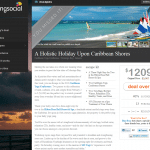Digital marketing for health clubs, yoga studios and medical practices is awesome, right? Target prospects by household income and interests, deliver a tailored message, then re-market across the web using cookies, tags, and session variables. You can finally answer the million-dollar question: “Which marketing campaigns REALLY worked?”
All this greatness…when wouldn’t you do this, right?
Turns out there are still good reasons to include offline marketing in your promotional mix. And sometimes, it’s actually a smarter choice than digital.
When you’re targeting a neighborhood, not a geo radius
If your (generally accurate) assumption is that no one looking for a gym will drive more than 10 minutes or cross a major highway, targeting a geo radius from your physical storefront makes sense.
On the other hand…a singular focus on drive time and “trading area” doesn’t consider subtle changes in the demographics of neighborhoods. For instance, within North Dallas, Highland Park is known for expensive estates and wealthy residents. A short distance north, the neighborhood is more commercial and the houses are smaller and more densely placed. There’s more multi-family housing, the residents are generally younger, and household income is lower — yet they’re all within the same radius and the same zip.
Yes, you can dial in your digital marketing to audience, demographics, and a tighter geo radius. Prospects from the other side of the highway might come, since after all they’re within driving radius.
Or…you could just use the good ol’ U.S. Post Office’s Every Door Direct Mail (EDDM) service and plop eye-catching oversized postcards right in front of potential members.
When you want drive-by and foot traffic, not clicks
Most gym membership signups begin with a tour or trial membership. It’s unusual for someone to sign up based only on a website visit.
So a postcard offer to non-members for free one-day use of the swimming pool with a newsletter signup might fare better as a handout at free pizza Wednesdays than a typical AdWords or Facebook campaign.
Or maybe it makes even more sense to partner with nearby local businesses who serve like-minded customers to market your club or fitness business.
Keep your visual presence in mind too. Most fitness businesses have a buzz of activity. It’s a high-energy setting. Ask yourself what you can do to really attract walk-in and drive-by traffic. Think strategically — don’t take the lazy way out with a giant inflatable gorilla or a few banners with your logo stuck in the ground.
How can you capitalize on your visuals? The new storefront…rows and rows of smiling people tuned into their workout on your brand new Woodway treadmills. Sure, web video’s great — but nothing beats an in-person experience.
You can always supplement walk-in and drive-by targeting with digital marketing — but why go exclusively digital and miss out on all these in-person selling opportunities?
When your marketing message is best delivered in person
If you’re a local brick and mortar business, one of your greatest assets should be your facility and your team.
Focus on marketing initiatives that invite people to your location to experience your fitness or wellness business, rather than trying to get them to buy off a display network ad or social media promotion. Use your digital dollars just to extend the invitation, not replace it.
Tours and trial memberships are just the beginning. You can do so much more. For example, you might offer a public seminar on a health topic uniquely tied to your business, or invite people to meet a local fitness or nutrition celebrity.
Once you have folks in the room, you have an audience. You’ve got your crack team of staff who do a great job of connecting one-on-one. You can answer questions, explore potential members’ interests and concerns, and shepherd the sales process. Don’t forget special offers available just to the folks who show up in person!
Sure, you can sell online and conduct marketing activities like webinars online — but if you’re not offering a strictly or primarily online program or service, focusing exclusively on online marketing leaves customers and revenues on the table.
When you’re on a very tight budget
Doing pay-per-click right requires an upfront investment. You have to pay for the actual clicks and conversions, and you have to pay a PPC agency to build and manage your campaigns if you want real results. The Adwords and Facebook advertising tools make it look easy — but the devil’s in the details, and the only people who actually know all those details are the folks who are in the business of actually managing these campaigns, day in and day out. They keep up with algorithm changes, best practices, and know how to slice and dice your results to pinpoint problems and opportunities.
Without that investment, you’ll quickly find yourself paying hundreds or thousands of dollars every month with little insight into whether (and how many) clicks actually turned into members.
If you’re not willing or able to make that investment, don’t even attempt pay-per-click. It’s not the only game in town. Instead, focus on direct mail, co-marketing with businesses that attract similar customers, and capitalizing on public events. And when you go digital, focus on your organic Facebook presence through your business page and Facebook groups, not paid advertising.
When you’re promoting your club at events & expos
One year when I ran the Dallas Marathon, freezing weather surprised Texas two days before the race. I didn’t have arm warmers and none of my local running stores seemed to have them either—it doesn’t usually stay cold for very long in Texas!
However: when I picked up my bib and swag bag, I noticed a print coupon for the Pearl Izumi booth in the vendor expo. I made a beeline for that booth and got two pairs just in case I lost one. Oh, and a vest that was an impulse buy!
Would I have been particularly interested in a QR code to scan for special online offers? Not particularly, since I’d still be without arm warmers. They had to be on the spot, ready to sell and with inventory available to fill orders then and there.
Can you sell memberships simply by telling booth visitors to scan a QR code and enter their information for a coupon code? Yes, but it’s annoying, and in these situations, nothing beats an on-the-spot, going-away-tomorrow, take-it-or-leave-it promotion.
When you can co-market with like-minded businesses
If your yoga studio offers classes on maintaining flexibility and balance for sports, wouldn’t it make sense to reach out to a karate studios, triathlon stores and coaches and local bike shops in your area and work on a co-marketing strategy? How about the community college’s sports program? What about local club and elite soccer or lacrosse teams?
It’s a win-win strategy, and you’ll certainly pay less per lead that you would from bidding against competitors for keywords.
When your product offers natural in-person marketing opportunities
Say you just published a healthy lifestyles cookbook. Have you thought about working with local grocers, farmers markets, and stores that sell kitchen items and cookware to arrange special appearances, demos or cooking classes? Could you coordinate with local community colleges or universities and their Human Nutrition programs to do something interesting? What about appearances on local morning TV shows? How about offering a book signing or in-person opportunity to book clubs that choose your cookbook as one of their monthly titles?
Digital is great; but it’s also tough to carve out your share of the available attention. Focus only on digital channels, and you’re missing out on the potentially greater value of a multi-pronged approach.
Stay focused on the most effective tools and strategies for qualifying and developing the leads you obtain on all channels, and your reward will be a lower cost of acquisition, greater profits, and sustainable growth that builds on the unique strengths of your business and local market.




